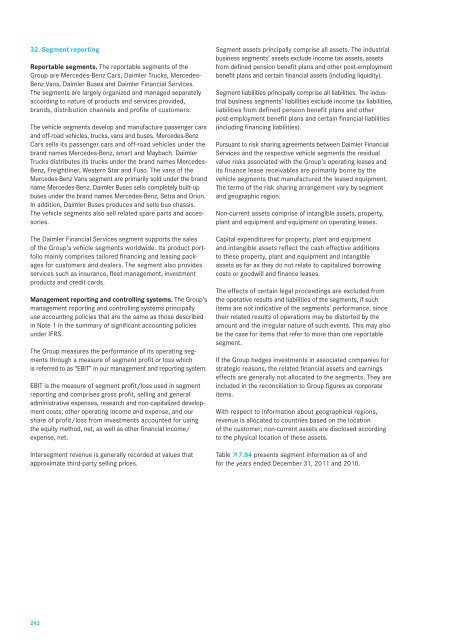Daimler Annual Report 2011 - Alle jaarverslagen
Daimler Annual Report 2011 - Alle jaarverslagen
Daimler Annual Report 2011 - Alle jaarverslagen
You also want an ePaper? Increase the reach of your titles
YUMPU automatically turns print PDFs into web optimized ePapers that Google loves.
32. Segment reporting<br />
<strong>Report</strong>able segments. The reportable segments of the<br />
Group are Mercedes-Benz Cars, <strong>Daimler</strong> Trucks, Mercedes-<br />
Benz Vans, <strong>Daimler</strong> Buses and <strong>Daimler</strong> Financial Services.<br />
The segments are largely organized and managed separately<br />
according to nature of products and services provided,<br />
brands, distribution channels and profile of customers.<br />
The vehicle segments develop and manufacture passenger cars<br />
and off-road vehicles, trucks, vans and buses. Mercedes-Benz<br />
Cars sells its passenger cars and off-road vehicles under the<br />
brand names Mercedes-Benz, smart and Maybach. <strong>Daimler</strong><br />
Trucks distributes its trucks under the brand names Mercedes-<br />
Benz, Freightliner, Western Star and Fuso. The vans of the<br />
Mercedes-Benz Vans segment are primarily sold under the brand<br />
name Mercedes-Benz. <strong>Daimler</strong> Buses sells completely built-up<br />
buses under the brand names Mercedes-Benz, Setra and Orion.<br />
In addition, <strong>Daimler</strong> Buses produces and sells bus chassis.<br />
The vehicle segments also sell related spare parts and accessories.<br />
The <strong>Daimler</strong> Financial Services segment supports the sales<br />
of the Group’s vehicle segments worldwide. Its product portfolio<br />
mainly comprises tailored financing and leasing packages<br />
for customers and dealers. The segment also provides<br />
services such as insurance, fleet management, investment<br />
products and credit cards.<br />
Management reporting and controlling systems. The Group’s<br />
management reporting and controlling systems principally<br />
use accounting policies that are the same as those described<br />
in Note 1 in the summary of significant accounting policies<br />
under IFRS.<br />
The Group measures the performance of its operating segments<br />
through a measure of segment profit or loss which<br />
is referred to as “EBIT” in our management and reporting system.<br />
EBIT is the measure of segment profit/loss used in segment<br />
reporting and comprises gross profit, selling and general<br />
administrative expenses, research and non-capitalized development<br />
costs, other operating income and expense, and our<br />
share of profit/loss from investments accounted for using<br />
the equity method, net, as well as other financial income/<br />
expense, net.<br />
Intersegment revenue is generally recorded at values that<br />
approximate third-party selling prices.<br />
Segment assets principally comprise all assets. The industrial<br />
business segments’ assets exclude income tax assets, assets<br />
from defined pension benefit plans and other post-employment<br />
benefit plans and certain financial assets (including liquidity).<br />
Segment liabilities principally comprise all liabilities. The industrial<br />
business segments’ liabilities exclude income tax liabilities,<br />
liabilities from defined pension benefit plans and other<br />
post-employment benefit plans and certain financial liabilities<br />
(including financing liabilities).<br />
Pursuant to risk sharing agreements between <strong>Daimler</strong> Financial<br />
Services and the respective vehicle segments the residual<br />
value risks associated with the Group’s operating leases and<br />
its finance lease receivables are primarily borne by the<br />
vehicle segments that manufactured the leased equipment.<br />
The terms of the risk sharing arrangement vary by segment<br />
and geographic region.<br />
Non-current assets comprise of intangible assets, property,<br />
plant and equipment and equipment on operating leases.<br />
Capital expenditures for property, plant and equipment<br />
and intangible assets reflect the cash effective additions<br />
to these property, plant and equipment and intangible<br />
assets as far as they do not relate to capitalized borrowing<br />
costs or goodwill and finance leases.<br />
The effects of certain legal proceedings are excluded from<br />
the operative results and liabilities of the segments, if such<br />
items are not indicative of the segments’ performance, since<br />
their related results of operations may be distorted by the<br />
amount and the irregular nature of such events. This may also<br />
be the case for items that refer to more than one reportable<br />
segment.<br />
If the Group hedges investments in associated companies for<br />
strategic reasons, the related financial assets and earnings<br />
effects are generally not allocated to the segments. They are<br />
included in the reconciliation to Group figures as corporate<br />
items.<br />
With respect to information about geographical regions,<br />
revenue is allocated to countries based on the location<br />
of the customer; non-current assets are disclosed according<br />
to the physical location of these assets.<br />
Table 7.84 presents segment information as of and<br />
for the years ended December 31, <strong>2011</strong> and 2010.<br />
242

















